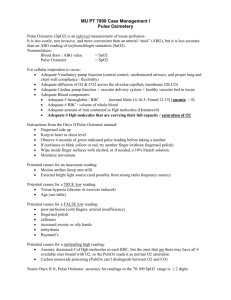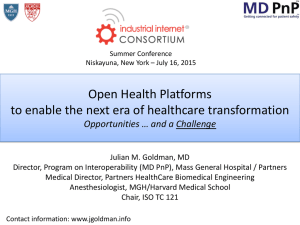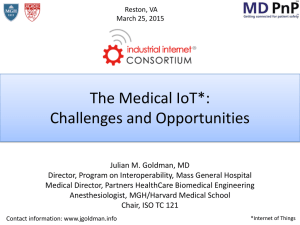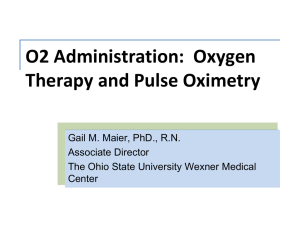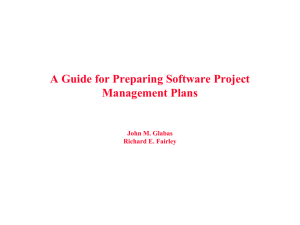Federal-Health-IT-Summit-2014-11-18
advertisement
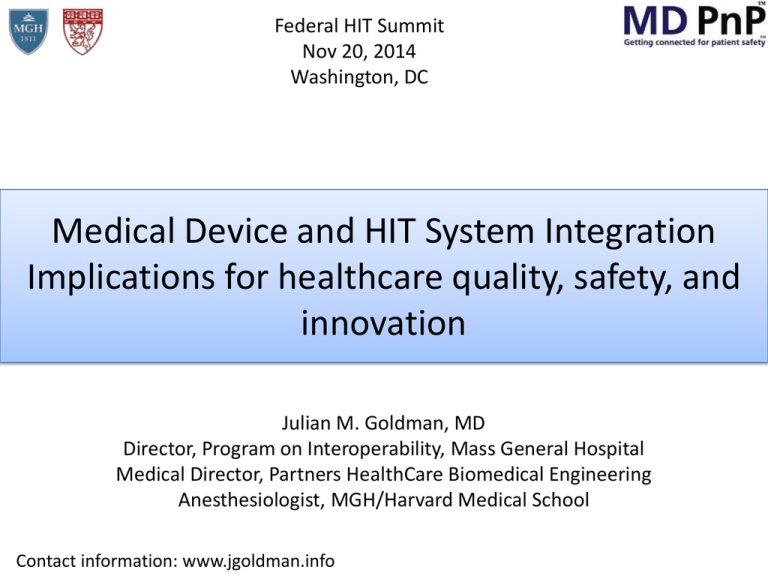
Federal HIT Summit Nov 20, 2014 Washington, DC Medical Device and HIT System Integration Implications for healthcare quality, safety, and innovation Julian M. Goldman, MD Director, Program on Interoperability, Mass General Hospital Medical Director, Partners HealthCare Biomedical Engineering Anesthesiologist, MGH/Harvard Medical School Contact information: www.jgoldman.info 1999 • • • • 2013 1999 IOM published “To Err Is Human” up to 98,000 people a year die because of mistakes in hospitals. 2010 the Office of Inspector General for Health and Human Services said that bad hospital care contributed to the deaths of 180,000 patients in Medicare alone in a given year. 2013 Journal of Patient Safety: between 210,000 and 440,000 patients each year who go to the hospital for care suffer some type of preventable harm that contributes to their death. “That would make medical errors the third-leading cause of death in America, behind heart disease, which is the first, and cancer, which is second. “ Devices, processes, non-integrated system errors Home ventilator OR scene – patient’s life saved: Clinicians need timely, accurate data to reduce error, treatment delays, injuries and deaths. Is that how we practice today? Where are innovative solutions? Medical Devices generate “First Mile” of data (from patient) Pulse Oximeters measure oxygen saturation – displayed as SpO2 % Pulse Oximeter oxygen saturation is 84% on instrument display and in EHR EMR Blood Pressure Bluetooth pulse oximeter Julian M. Goldman, MD / MGH These infusion pumps are for use on ONE patient Medical Devices are also the “Last Mile” (data back to devices) Example - Infusion technology: 1. Decision support? 2. Prevent contra-indicated infusion? 3. “Artificial pancreas” Capabilities? (closed loop) 4. Consolidate all data for adverse event analysis? 5. Check device status, software version? Recall? 6. Adjust settings remotely? In interdisciplinary settings, language matters … Actual screen capture from intra-operative EMR during surgery Julian M. Goldman, MD / MGH Discrete, device-based alarms Low SpO2 Alarm = 90% Resp rate Alarm < 8 or > 20 ETCO2 >x or <x? Must function without context Context-based “smart” alarms Is this an IOT approach? Maybe … EMR Smart Alarm Low SpO2 Alarm = 80% • Use trends • Data fusion • context Resp rate Alarm < 8; CO2 > 60 Correct Time Pulse Oximeter Data example Oxygen Level Low WHY???? JM Goldman MD / MGH BP cuff - Pulse Oximeter Interaction Not reall low oxygen “Bad” data JM Goldman MD / MGH Baseline Cuff inflates – loss of finger signal Blood returns to finger We must not discard data!! No evidence of 84% SpO2 in EHR (Blue ticks representing SpO2 values Don’t change) Monitor Displays Low Oxygen Level (SpO2) Alarm Event “84%” at 2:07 Julian M. Goldman, MD / MGH Sources of variation in EHR documentation due to Data Sampling 60 Seconds Example of possible EHR sample points for 1-minute recording Patient’s “actual” SpO2 minimum = 70% Based on this example, EHR May record SpO2 as: 98% 92% 80% 75% Etc. Proposal: Can an Integrated Clinical Environment (ICE) add “error resistance” to healthcare delivery? Standard for the “Integrated Clinical Environment” ASTM F2761-09 “Essential safety requirements for equipment comprising the patient-centric integrated clinical environment (ICE) — Part 1: General requirements and conceptual model” Provides a standards-based system architecture intended to support safe interoperable medical systems Recognized by FDA 8/2013: http://www.gpo.gov/fdsys/pkg/FR-2013-08-06/pdf/2013-19020.pdf Integrated Clinical Environment - Architecture From ASTM F2761-09 Clinicians ICE System Apps for PCA Safety, Smart Alarms, Remote Notification, Team coordination EMR ICE External Interface ICE Supervisor (runs apps) ICE Network Controller Medical Device or other equipment Medical Device or other equipment ICE Data Logger Medical Device or other equipment Patient and Family Standard recognized by FDA in August 2013 OpenICE Open-Source Platform Based on ASTM F2761 “Essential safety requirements for equipment comprising the patient-centric integrated clinical environment (ICE), IEEE 11073 nomenclature; OMG DDS pub/sub messaging middleware Apps Caregiver ICE Supervisor Black Box Recorder External Network Network Controller Data Logger Adapter Adapter Adapter PulseOx Pump Patient Mon. Patient www.openice.info “Medical IoT” (Internet of Things) Apps for smart alarms; med safety; equipment management What if… Asking a lot of the platform Medical Device “Plug-and-Play” Interoperability Program (MD PnP) Founded in 2004, the MD PnP research program is a multi-institutional community with Lab based at Massachusetts General Hospital (MGH), with grant support from NIH/NIBIB, NSF, DoD/TATRC, and NIST Mission: lead the adoption of open standards and technologies for medical device interoperability to improve patient safety MD PnP Lab at MGH/PHS • Vender-neutral sandbox for experimenting with device interoperability solutions (standards technologies, products) • Contains devices – production and research • Supports diverse collaborators www.openice.info www.mdpnp.org
